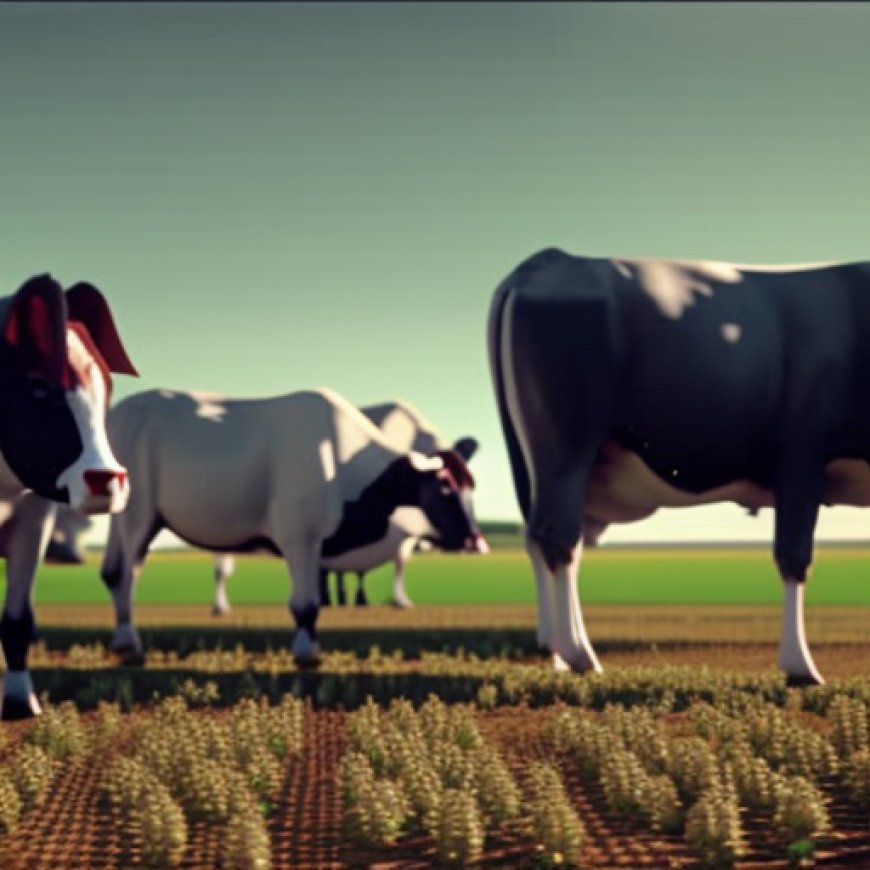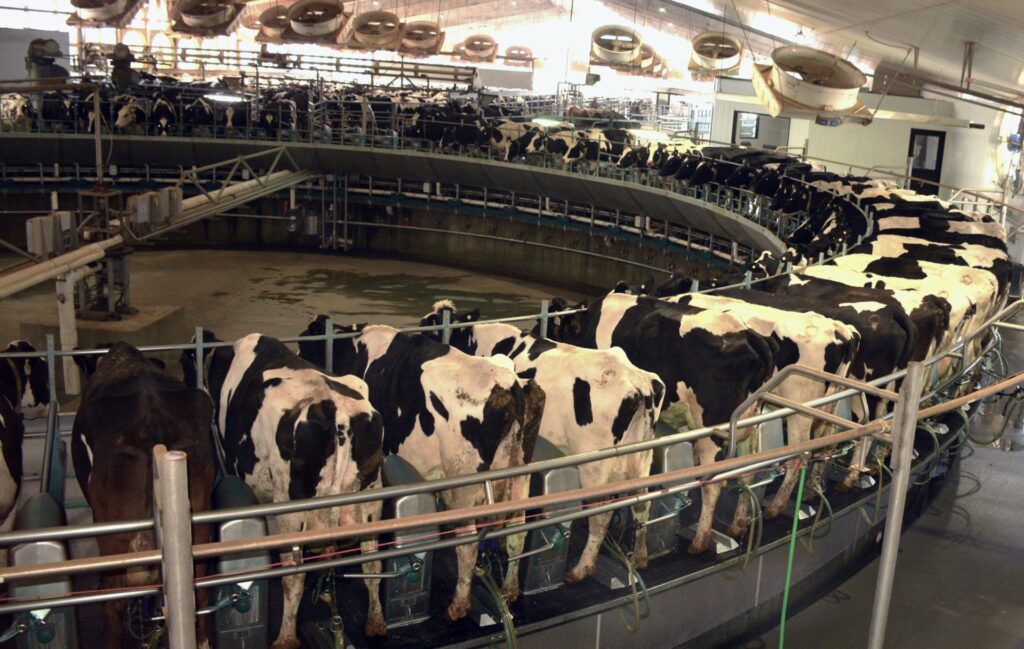Technology advances attract dairy producers from two states to Southwest Dairy Day – AgriLife Today
Technology advances attract dairy producers from two states to ... AgriLife Today


The Texas A&M AgriLife Extension Service’s 2023 Southwest Dairy Day
The Texas A&M AgriLife Extension Service’s 2023 Southwest Dairy Day drew dairy producers from a two-state area to view cutting-edge technology, including an anaerobic digester and rotary parlor with automated sanitation capabilities.


Dairy producers seek automation and precision technologies
Dairy producers are looking for automation and precision technologies that will help them further their revenue streams and increase the efficiency of their operations, said Juan Piñeiro, DVM, Ph.D., AgriLife Extension dairy specialist and assistant professor in the Texas A&M College of Agriculture and Life Sciences Department of Animal Science, Amarillo.
Piñeiro estimated roughly 400 people from Texas and New Mexico attended the event.
“Dairy farmers, allied industry professionals and people from local communities who participated mentioned they were very happy with the event and getting to tour a high-tech farm like Del Rio Dairy,” he said.
One attendee was Frans Osinga from Proctor, who runs a 1,500-cow dairy. He came to see the anaerobic digester, which turns dairy manure into high-quality fertilizer, as well as other technologies that the vendors were featuring that he can implement on his operation.
For instance, he said the wide variety of sensors now available to be placed on cows are expected to save time and money. The sensors can show him at the touch of a button on his phone the animal’s temperature for breeding, rumination and signs of sickness. This saves labor, antibiotics and hormone use.
“These technologies allow the cow to stay in the pen and not be stressed by moving them to a sick pen – essentially we give them two aspirin and a bolus, and they never leave the pen,” Osinga said. “It’s a lot less stressful for our cows.”
Precision technology and automation
Sushil Paudyal, Ph.D., assistant professor in dairy science in the Department of Animal Science, Bryan-College Station, helped discuss the precision technologies and automation for attendees.
Some of the technology included activity monitoring systems for cows, automatic pre- and post-teat dipping systems and automated cow sorting systems.
“As these new technologies are becoming more and more available to dairy producers, it is crucial to evaluate if a given technology is truly a good fit for the particular farm and what benefits they hope it will provide to their operation,” Paudyal said.
Paudyal said return on investment from these systems largely depends on how fully the producer can utilize the capabilities of the technology and leverage the data generated to inform management decisions.
“While the systems offer cutting-edge technology, simply implementing them will not guarantee improvements — they must be carefully integrated into day-to-day farm management and farms should be eager to use the data for management decisions,” he said.
Anaerobic digester technology
A specific technology many of the dairy operators came to see was the anaerobic digester on the premises.
SDGs, Targets, and Indicators
1. SDGs addressed or connected to the issues highlighted in the article:
- SDG 2: Zero Hunger
- SDG 7: Affordable and Clean Energy
- SDG 9: Industry, Innovation, and Infrastructure
- SDG 12: Responsible Consumption and Production
- SDG 13: Climate Action
2. Specific targets under those SDGs based on the article’s content:
- SDG 2.4: By 2030, ensure sustainable food production systems and implement resilient agricultural practices that increase productivity and production, that help maintain ecosystems, that strengthen capacity for adaptation to climate change, extreme weather, drought, flooding, and other disasters, and that progressively improve land and soil quality.
- SDG 7.2: By 2030, increase substantially the share of renewable energy in the global energy mix.
- SDG 9.4: By 2030, upgrade infrastructure and retrofit industries to make them sustainable, with increased resource-use efficiency and greater adoption of clean and environmentally sound technologies and industrial processes.
- SDG 12.4: By 2020, achieve the environmentally sound management of chemicals and all wastes throughout their life cycle, in accordance with agreed international frameworks, and significantly reduce their release to air, water, and soil in order to minimize their adverse impacts on human health and the environment.
- SDG 13.2: Integrate climate change measures into national policies, strategies, and planning.
3. Indicators mentioned or implied in the article:
- Efficiency of dairy operations in revenue generation and resource utilization
- Adoption of automation and precision technologies in dairy farming
- Reduction of labor, antibiotics, and hormone use through sensor technology
- Utilization of data generated by precision technologies for management decisions
- Economic viability of anaerobic digester technology through biogas sales
- Reduction of greenhouse gas emissions through anaerobic digesters
- Effectiveness of anaerobic digesters in reducing pathogens and odor of manure
- Conservation and availability of nutrients in post-digestion effluent for crop production
Table: SDGs, Targets, and Indicators
| SDGs | Targets | Indicators |
|---|---|---|
| SDG 2: Zero Hunger | 2.4: By 2030, ensure sustainable food production systems and implement resilient agricultural practices that increase productivity and production, that help maintain ecosystems, that strengthen capacity for adaptation to climate change, extreme weather, drought, flooding, and other disasters, and that progressively improve land and soil quality. | – Efficiency of dairy operations in revenue generation and resource utilization – Adoption of automation and precision technologies in dairy farming |
| SDG 7: Affordable and Clean Energy | 7.2: By 2030, increase substantially the share of renewable energy in the global energy mix. | – Economic viability of anaerobic digester technology through biogas sales |
| SDG 9: Industry, Innovation, and Infrastructure | 9.4: By 2030, upgrade infrastructure and retrofit industries to make them sustainable, with increased resource-use efficiency and greater adoption of clean and environmentally sound technologies and industrial processes. | – Adoption of automation and precision technologies in dairy farming |
| SDG 12: Responsible Consumption and Production | 12.4: By 2020, achieve the environmentally sound management of chemicals and all wastes throughout their life cycle, in accordance with agreed international frameworks, and significantly reduce their release to air, water, and soil in order to minimize their adverse impacts on human health and the environment. | – Reduction of labor, antibiotics, and hormone use through sensor technology |
| SDG 13: Climate Action | 13.2: Integrate climate change measures into national policies, strategies, and planning. | – Reduction of greenhouse gas emissions through anaerobic digesters |
Behold! This splendid article springs forth from the wellspring of knowledge, shaped by a wondrous proprietary AI technology that delved into a vast ocean of data, illuminating the path towards the Sustainable Development Goals. Remember that all rights are reserved by SDG Investors LLC, empowering us to champion progress together.
Source: agrilifetoday.tamu.edu

Join us, as fellow seekers of change, on a transformative journey at https://sdgtalks.ai/welcome, where you can become a member and actively contribute to shaping a brighter future.







